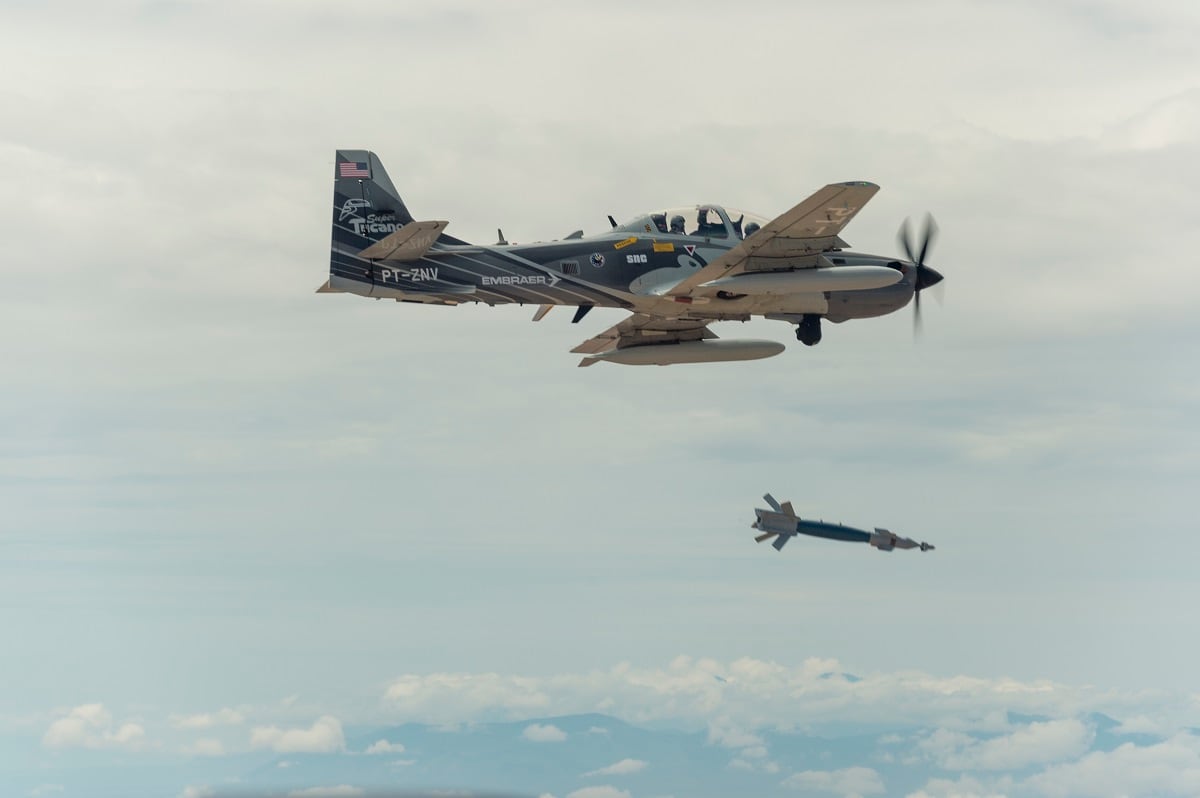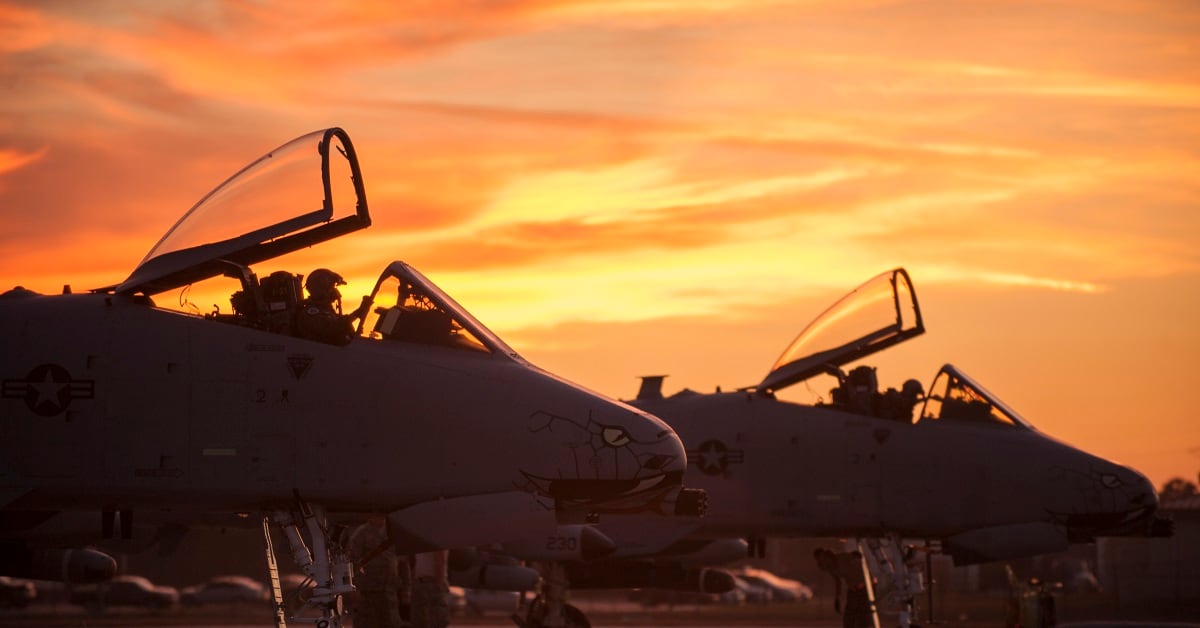FARNBOROUGH, England — Most analysts view the Air Force’s potential light attack aircraft competition as a face off between two longtime rivals: Textron’s AT-6 and the A-29 Super Tucano manufactured in a Sierra Nevada Corp.-Embraer partnership.
But that hasn’t stopped a number of foreign companies from showcasing their products at Farnborough Air Show as contenders for an eventual U.S. Air Force requirement for light attack planes, also known as OA-X.
Czech aerospace firm Aero Vodochody would propose two of its jet engine-powered platforms, the L-39NG trainer and the F/A-259 attack aircraft. South Africa’s Paramount Group wants to enter a new aircraft that it has called the Bronco II, after the famed OV-10 Bronco used by the U.S. military throughout the Vietnam War.
However, both companies face an uphill battle to even get their foot in the door.
Click here for more from Farnborough Airshow 2018!
For one, neither company has been involved in either of the two experimentation phases carried out at Holloman Air Force Base in New Mexico.
"We are disadvantaged,” Paramount Group Chairman Ivor Ichikowitz told Defense News during a July 18 interview at Farnborough. “At the point when the experiment started, we were just going into production with a 2018 technology airplane.”
Meanwhile, Aero Vodochody submitted its F/A-159 — an earlier version of the F/A-259 it’s now trying to promote — and was accepted into the first light attack experiment, said Giuseppe Giordo, the company’s president and CEO. However, the company didn’t have enough time to push its aircraft through the clearance process to fly in the United States.
RELATED

The U.S. Air Force recently ended flight tests of the AT-6 and A-29 after a U.S. Navy pilot died tragically during an A-29 flight at Holloman AFB. However, the second phase of light attack experimentation will continue this summer with evaluations of network connectivity and maintenance procedures that can be carried out on the ground.
The service hasn’t made a final decision on whether to start a program or what its exact requirements might be, but it could release a request for proposals as soon as December for a contract award by the end of fiscal 2019, said Lt. Gen. Arnold Bunch, the service’s top uniformed acquisition official, during a July 7 news conference.
However, it’s possible the service could limit a future competition to only the AT-6 and A-29 — and leaders seem to be leaning in that direction.
“The whole way we got to where we’re at, we put out an invitation to participate, and we only had two that met all of the criteria that we were looking for,” Bunch said. “We experimented with those, and they performed well enough that we did another phase, and those are the only two that we invited in [for phase two]. So at this point right now I’m seeing it as a competition between two airplanes.”
That hasn’t deterred executives at Aero Vodochody and Paramount from pushing their platforms as potential OA-X contenders.
“We are expecting you to have, obviously, a competition,” Giordo said. “The reality is that — following the U.S. federal acquisition regulations — they will open any competition they will have and give time to test the L-259 and the L-39NG.”
Giordo’s assessment of the situation doesn’t necessarily reflect the actuality of the U.S. acquisition law. The U.S. military can and has limited the number of competitors for specific programs. For instance, the Navy’s MQ-25 tanker drone competition has been restricted to four U.S. manufacturers.
The companies also face significant hurdles due to the design of the planes themselves. During the light attack experiment, the Air Force has gravitated toward off-the-shelf turboprop aircraft designed with ejection seats that can be outfitted to carry a variety of sensors and weapons.
Aero Vodochody’s L-39NG and F/A-259 are jet-powered aircraft, but Giordo contends that both are better choices for the U.S. Air Force.

“Without giving numbers, the operating cost per flight hour in our platform is almost the same as a turboprop,” he said. “Obviously we have much more endurance. Obviously we have much more range, and obviously in terms of payload capability, we can have a much bigger payload capability.”

The Bronco II, a turboprop aircraft, looks more akin to the AT-6 and A-29. However, it is still unproven. An earlier iteration of the plane — known as the Advanced High Performance Reconnaissance Light Aircraft or AHRLAC — first flew in 2014, and Ichikowitz said the militarized version of the AHRLAC — called Mwari — is in production for undisclosed customers.
But the first Bronco II, which is a version of the Mwari built for the U.S. market, won’t come off the production line until this year. Then it will transfer to the United States for “fit and finish,” Ichikowitz said.
That could be around the same point the U.S. Air Force is ready to start a competition,
Both Aero Vodochody and Paramount Group are very conscious of President Donald Trump’s Buy American rhetoric. A key part of their sales strategy revolves around promising to bring production of the aircraft to the United States and highlighting the potential for new job opportunities and construction projects.
"The airplane will be produced in the United States. It will have an excess of 75 percent U.S. content. It talks completely to the president’s ‘Made in America’ strategy,” said Ichikowitz, who declined to comment on which U.S. company will produce it.
“It’s important to note that we are not specifically fielding the Bronco II in America only for OA-X. The OA-X program is a big program, it’s a complicated program, it’s already quite advanced, and we see many other use cases for the airplane besides OA-X,” he said, citing opportunities in the special operations and border patrol communities.
RELATED

If selected as the winner for OA-X, Aero Vodochody would also build its L-39 or F/A-259 aircraft in the United States, said Giordo. It plans to announce a U.S. prime contractor at the same time the Air Force launches a competition, and that firm would not only be responsible for overseeing the production aspects of the aircraft but also the logistics and sustainment services.
“We will produce the aircraft in the United States of America, but we have also to consider the transition of the production capability that will not add risk to the program,” he said.
Giordo believes Aero could stand up a U.S. production facility in about a year and would manufacture the first 14 or so aircraft in the Czech Republic before transitioning to the U.S. line.
Valerie Insinna is Defense News' air warfare reporter. She previously worked the Navy/congressional beats for Defense Daily, which followed almost three years as a staff writer for National Defense Magazine. Prior to that, she worked as an editorial assistant for the Tokyo Shimbun’s Washington bureau.








